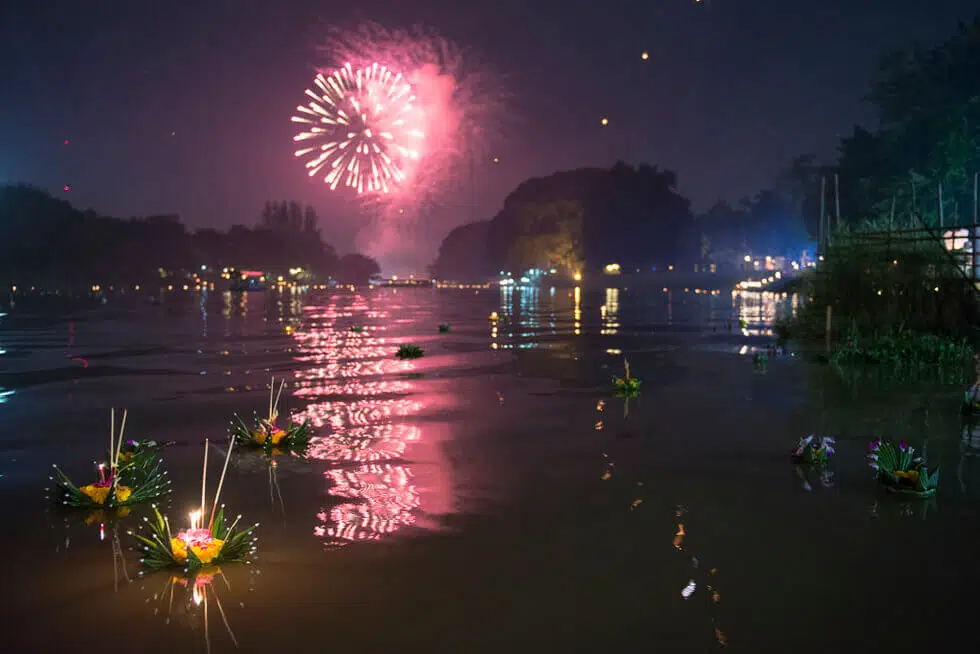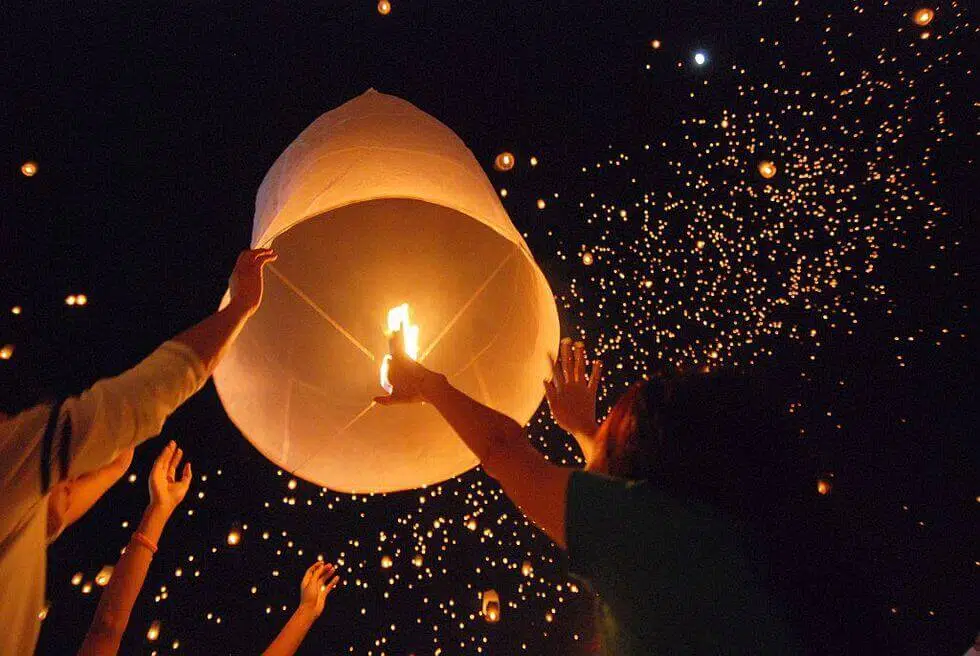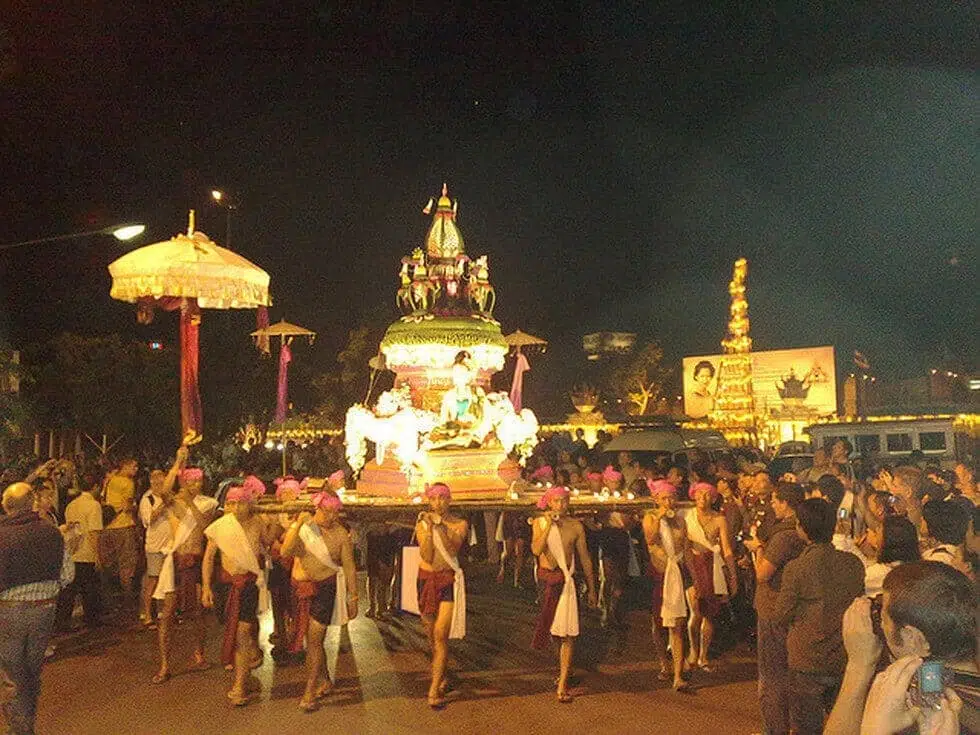Loy Krathong (ลอยกระทง), sometimes spelled Loy Kratong or Loi Kratong, is a festival held every year on the full moon of the twelfth month in the Thai Lunar Calendar. This means the dates move around from year to year, but it is generally in October or early November.
This Thai Festival is actually a merger of two traditional festivals: the Northern Thailand and Northern Myanmar Yee Peng / Yi Peng lantern festival is combined with the Central Thai Loy Krathong / Loi Kratong (ลอยกระทง) river offering festival.
Loy Krathong is held all over the country, but there are significant events held in Chiang Mai, Ayutthaya, and Sukhothai, where the celebrations take place over several days. The festival, while not an official, government holiday, are now held throughout Thailand including Bangkok, Phuket and Pattaya, as well as parts of Myanmar (Shan State) and Laos.
Schedule for 2018 Loy Krathong / Yi Peng
Thursday, November 22nd - Sunday, November 25th.
Yee Peng / Loy Krathong in Chiang Mai
In Chiang Mai the celebration is known as Yee Peng / Yi Peng (ยี่เป็ง) (literally, the full moon of the second month), as the twelfth month in the Thai Lunar Calendar corresponds to the second month in the traditional calendar of the old northern Lanna kingdom. The festival has illuminated lanterns, which are either carried, displayed in houses and temples, and even launched into the night sky. Krathong which are an offering -- traditionally made out of a banana stalk and adorned with candles, incense and some money -- are floated down the rivers.
The hazards of floating candle balloon (the lanterns float on hot air generated by a lit waxed votive) has increased dramatically as the celebration has become more popular among tourists. Over the past few years there have been threats by the government to arrest people who either sell the lanterns or release them at the wrong place or time. Airline flights have been disrupted due to the floating hazards.
Nevertheless, for now, and especially at certain times and places (the Ping river at night, especially around the Ratanakosin and Narawat bridges, to the east of the moat).
Loy Krathong generally takes place over one or two days. In Chiang Mai, Yee Peng turns into a three day festival, though there are events in various places in Thailand scattered over five or six days. The focus of celebrations in Chiang Mai is around the Saphan Nawarat Bridge that connects Tha Pae Road on the western side of the river with Charoen Muang Road on the other side.
Vendors on the eastern side of the bridge sell khom loy, fireworks and also beer and whiskey. Obviously, alcohol, gunpowder and kerosene make for a dangerous combination, so be careful. On the western side of the river bamboo landings will have been constructed where people can launch their krathongs into the water. Take note that on previous occasions drunken youths have thrown fireworks at the crowd and each other. The police make an effort to regulate the younger element, but they cannot be everywhere.
A more sedate and spiritual venue can be found at the temple of Wat Chai Mongkol, which is about two kilometers south of the bridge along Charoen Phratet Road. The temple has its own concrete landing on the river, where devotees can launch their krathongs. Throughout the evening hundreds of Khom Loy are launched into the air from the temple grounds. Khom Loy can be bought from vendors inside the temple.
The Loy Krathong Parade features giant illuminated krathongs, on top of which are perched candidates for the upcoming beauty contest. It usually leaves Tha Pae Gate for the Night Market early on the evening of the first day of the festival.
For something much more low key (and for those who have not been drinking), check out Wat Chedlin inside the old moat a few blocks from Chiang Mai Gate, which usually has a nice display and small Chedi (and a koi pond in the back), and Wat Phan Tao next to Wat Chedi Luang (a few blocks down from Wat Chedlin). These events are a favorite of photographers.
Illuminated Lanterns for Loy Krathong / Yee Peng
In the north of Thailand there are four different kinds of illuminated lantern or Khom. They are made of paper, but often contain a bamboo cylinder inside it to protect the paper from the heat of the candle. Firstly, there is the Khom Theua or carrying lantern. Locals will carry this lantern with them on the Loy Kratong parade. Later it will be taken to the temple and used to decorate the temple buildings.
Secondly there is the Khom Kwaen (hanging lantern), which is offered to pay respects to the Buddha. They are made in four shapes: the star, the alms bowl, the basket and the wheel. Thirdly, there is the Khom Paad. This one revolves on a vertical axis, the heat from the candle spinning a wheel. This circular shaped lantern will often feature the twelve signs of the horoscope. This type of lantern can only be placed within the temple gates. Finally, there is the famous Khom Loy. This lantern is actually a small hot air balloon, and the most famous of them all.
Sky Lanterns - Khom Loy / Khom Fai
The Khom Loy, also known as Khom Fai, is a cylinder of paper about one meter high, braced with wire circles. Suspended from the bottom of the cylinder is a coil of cotton soaked in kerosene. Fireworks and firecrackers are also often attached to the tray. These catch fire and explode after the balloon is launched. Once the cotton is lit it takes about a minute for the air inside the cylinder to heat up enough to lift the balloon into the air.
It is believed that launching one of these balloons can send a person’s bad luck and misfortune away into the air, especially if it disappears from view before the fire goes out. Often people will say a short prayer before launching the balloon. Sometimes they will also place their address in the balloon, or write it on the outside. Anyone who later finds the balloon can then claim money from the sender. In this way the good fortune is shared.
Krathong - Floating Lights
The Krathong is a small floating offering about 20 centimeters in diameter. Traditionally this is made from the leaves and wood of the banana tree. The raft is decorated with flowers, a candle and an incense stick. People often leave a small coin in the krathong, and occasionally they will leave a lock of the hair or even nail clippings. On the night of the full moon, people will light the candle and the joss stick, say a prayer, and float their krathong down the river.
As with the Khom Loy, this is a way that bad fortune can be discarded and made to float away. Thousands of these will float down the river making for a beautiful and moving spectacle. Usually, at the same time, thousands of Khom Loy will be drifting across the sky, so that the night sky mirrors the spectacle on the water. Almost constant firework displays, and the splashes of small boys diving in to collect the coins in the krathongs, complete the picture, and make for an unforgettable experience.
Lanna or Chiang Mai came to adopt the Central Thai Loy Krathong festival only when King Rama V's Queen Dara Rasami (from Chiang Mai) came back to Chiang Mai from Bangkok, and floated a krathong into the Ping River. Since then, floating of krathong became popular among people in Chiang Mai and later was made even more popular by the Chiang Mai governor to promote tourism. Since then the beauty contest and Kratong Parade have replaced the original spirit of Yee Peng.
Noppamas Queen
Beauty contests are often a feature of Thai festivals and the Loy Krathong celebrations are no exception. According to legend Noppomas was a consort of the King of Sukothai in the fourteenth century. She was the daughter of a Brahmin priest at the King’s court. She made the first krathong out of banana leaves in the shape of a lotus flower and presented it to the King. He lit the candle and the incense stick and floated it on the water, so starting the tradition we know today. In fact, the floating of Krathongs (Loy Krathong means floating krathong) began as a Sukothai tradition, but was later grafted onto these festival celebrations all over Thailand. The Loy Krathong Parade usually features contestants in the Noppamas Queen beauty contest, which is always held as part of the celebrations.
Mae Jo Mass Lantern Launch
The most spectacular of the massed balloon launches takes place at the back of Mae Jo University, about 13 kilometers outside town. Note that the Mae Jo/Sansai lantern release is not a government or local event, but actually a private event, fairly recent, and is something a bit different than most people realize. The Mae Jo/Sansai lantern release is put on by the DMC, which is a Buddhist sect who specialize in large-scale events that are particularly photogenic. For more information about the DMC see the article on them in Foreign Policy This event is for Thai believers and the Thai so-called *hi-so* (high society) folks (who can afford it), tourists and photographers, but is not an actual government-sanctioned event, or an indigenous event, per se. This event, again, is separate. See the DMC website for more information.


